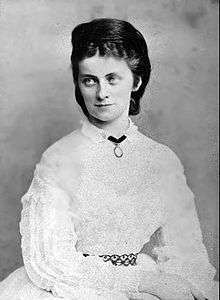Bazar de la Charité

The Bazar de la Charité was an annual charity event organized by the French Catholic aristocracy in Paris from 1885 onwards. It is best known for the fire at the 1897 bazaar that claimed 126 lives, many of them aristocratic women, the most eminent of whom was Her Royal Highness the Duchess of Alençon, née Sophie Charlotte of Bavaria,[1] sister of the famous Empress Sisi.
The Bazar de la Charité was held annually in a variety of locations, by a consortium of charitable organizations that joined to share renting fees, reducing costs and grouping potential buyers.
Fire of 1897

In 1897 the Bazar was held in a large wooden shed, 80 by 13 metres, at Rue Jean-Goujon 17, in the 8th arrondissement of Paris. Within this shed a fantasy medieval street was built with wood, cardboard, cloth and papier-mache. Exits were not properly marked.[2] These incidences would contribute considerably to the disaster.[3] A novel attraction at this Bazar was a room where the new spectacle of the time could be admired, moving images projected by the Lumière brothers' technology.
On the afternoon of 4 May, the second of the planned four days of the bazaar, the projectionist's equipment (using a system of ether and oxygen rather than electricity) caught fire.[4] The resulting blaze, and the panic of the crowd, claimed the lives of 126 people, mostly aristocratic women. Over 200 people were additionally injured from the fire.[5] The disaster was reported nationally and internationally.
Some of the visitors fleeing through the courtyard were saved by the cook and manageress of the Hôtel du Palais, M. Gauméry and Mme Roche-Sautier (respectively), who helped them escape the fire through the kitchen windows to the adjoining building.[6] The identification of charred remains by the use of dental records was a landmark in the early history of forensic dentistry.[7]
Chapel of Our Lady of Consolation

An expiatory chapel, Notre-Dame de Consolation, was built on the location of the Bazar. This chapel is dedicated to victims of fire and serves the Italian Catholic community in Paris.
See also
Bibliography
- ↑ New York Times (February 12, 1911). "Royal House of Bavaria and its Romances" (PDF). Web database. New York Times. Retrieved 2010-03-13.
- ↑ FireNet International (2010). "History of Fire Safety Legislation and other Interesting Facts". web address. Fire Net International. Archived from the original on June 11, 2009. Retrieved 2010-03-12.
- ↑ Michèle Fontana, "Faits divers et politique: l'incendie du Bazar de la Charité (1897)", in Regards populaires sur la violence, edited by Mireille Piarotas (Publications de l'Université de Saint-Étienne, 2000), pp. 101–107.
- ↑ Richard Abel, The Ciné Goes to Town: French Cinema, 1896–1914 (University of California Press, 1994), p. 17.
- ↑ FireNet International (2010). "History of Fire Safety Legislation and other Interesting Facts". web address. Fire Net International. Archived from the original on June 11, 2009. Retrieved 2010-03-12.
- ↑ Geoffrey Cubitt, "Martyrs of Charity, Heroes of Solidarity: Catholic and Republican Responses to the Fire at the Bazar de la Charité, Paris, 1897", French History 21/3 (2007), pp. 331–352.
- ↑ Mary Blume, "Remembering a Belle Époque inferno in Paris", New York Times, April 28, 2008.
- Marguerite Bourcet, Le Duc et la Duchesse d'Alençon: un couple de tragédie, 393 pages, Perrin, 1939 (2003 reprint, ISBN 2-262-02069-8)
- Dominique Paoli, Il y a cent ans: l'incendie du Bazar de la Charité, Paris, MDC, 1997.
- Venita Datta, Heroes and Legends of Fin-de-Siècle France, Cambridge University Press, 2011, pp. 33–75.
External links
- The Bazar de la Charité fire (French)
- The projection at the Bazar de la Charité (French)
- Projecteur et catastrophe
- Liste des victimes et des parents des victimes de l'incendie du Bazar de la Charité de A à G
- Liste des victimes et des parents des victimes de l'incendie du Bazar de la Charité de H à P
- Liste des victimes et des parents des victimes de l'incendie du Bazar de la Charité de Q à Z
- Blog de l'association du Bazar de la charité